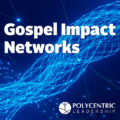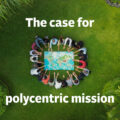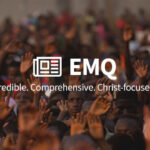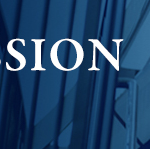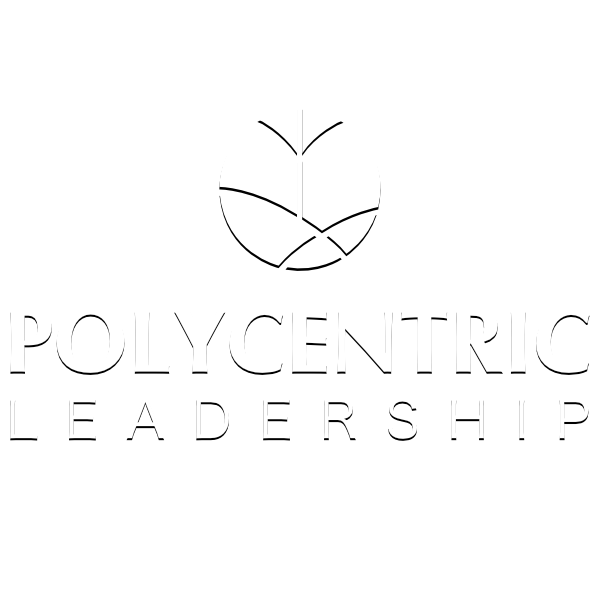BY JOSEPH HANDLEY
The breadth of Dr. Tetsunao “Ted” Yamamori’s influence for the modern mission movement is astounding. Few leaders have this expanse in their lifetimes, especially with the quality of work that Ted has shown over the years. This chapter focuses on leadership, particularly within the Lausanne Movement, of which Ted served as international director as well as senior associate for holistic mission.
In my own research, with keen attention to the Lausanne Movement, I discovered six distinct themes pertinent to this approach to leadership.[1] We begin with highlighting the importance of this polycentric theoretical model by looking at collaborative leadership and partnership.
Collaboration and Partnership
In looking at the history of the Lausanne Movement, Dr. Doug Birdsall, former executive chairman of the Lausanne Movement, made an interesting observation: “Consensus on a common goal is perhaps the most obvious ingredient for both intra- and inter-organizational collaboration. Individuals and organizations are unlikely to work in partnership if their goals are not in alignment and mutually beneficial.”[2]
In his book Well Connected, Phill Butler points out that what attracts people and keeps them committed to a partnership are (1) great vision and (2) seeing results.[3] According to Butler, once you have a compelling reason to work together and a desire for strong results, you must build trust. “All durable, effective partnerships are built on trust and whole relationships.”[4]Butler also, however, emphasizes this point:
Spiritual breakthroughs are not a game of guns and money. No human effort, expenditure of resources, or brilliant strategy will alone produce lasting spiritual change. Our partnerships must be informed and empowered by God’s Holy Spirit in order to be effective. The challenges of relationships, cultural and theological differences, technical and strategic issues, and sustainability can only be dealt with in a process rooted in prayer.[5]
Mark Oxbrow adds that “multi-cultural partnerships need multi-cultural objectives: we need to understand what is valued as ‘success’ or ‘achievement’ in each culture.”[6] Kärin Primuth reflects this, noting that multicultural networks are a demonstration of biblical unity:
Networks offer a context to build trust across cultures and to genuinely listen and learn from our partners in the Majority World. They provide a platform for dialogue with our brothers and sisters in the Global South to mutually define what the North American Church can contribute to today’s mission movement.[7]Global business leaders are suggesting this type of collaboration as well. Angel Cabrera and Gregory Unruh suggest that “global leaders craft solutions by bringing together people and resources across national, cultural, even organizational boundaries.”[8]
The ability to navigate across a variety of cultures, stakeholders, and global scenarios is a vital trait for empowered leadership in a globalized era. These leadership skills are captured in the six themes discovered in the research I did for my dissertation. They are seen in figure 2.1 and highlighted by the interviews with Lausanne Movement leaders in the next section.
POLYCENTRIC MISSION LEADERSHIP THEMES
|
Theme |
Component of the Theme |
|
Charismatic |
Charismatic | Value-based | Spiritual |
|
Collaborative |
Collaboration | Network | Participate | Shared | Collective |
|
Communal |
Community | Contractual or Cooperative | Own Ecosystem | Mutual Vision | Team |
|
Relational |
Empowerment | Encouragement | Relational |
|
Entrepreneurial |
Entrepreneurial | Freedom to Structure |
|
Diverse |
Diversity | Cross-cultural |
Figure 2.1
Interviews with Lausanne Movement Leaders
In interviewing thirty-three key leaders who were leading significant movements for the kingdom of God within the Lausanne Movement, I was able to discern issues, trends, and challenges they face, how they have grown and been formed as leaders, and how leadership has changed in the past twenty years. Each leader was chosen for either effectiveness in leading a current network, or the promise the leader showed in getting his or her networks established.
In analyzing the data, it became apparent that there are leadership aspects that are timeless as well as factors that can change over time. Long-standing leadership traits that several noted included being biblically formed, being committed to strong character formation, and demonstrating Christlike servant leadership. Faithfulness and humility are traits that find themselves deeply interwoven into this thread of spirituality. Other, more tangible threads related to the need for vision, passion, and relational competence.
All the leaders pointed to a spiritual dimension in their life story of how God clearly intervened and called them to ministry. Over and above this aspect of calling was a deep sense of the need for the Lord’s presence to enable them to serve the way in which they served.
The common issues driving the need for changes in leadership included globalization, economic disparity, migration, and technological advancement. They also advocated moving away from a broad vision toward a more clearly defined set of outcomes, complete with measurable qualities, as being important in the current era.
The changing leadership environment is significantly impacted by diversity and cross-cultural engagement. The need for more strategic and directional leadership was apparent as well. Brad Smith highlighted the importance of gift-based leadership rather than trait-based leadership. He felt that moving away from the more trait-oriented approaches is critical to faithful, missional leadership today and into the future. He characterized the leadership changes needed like this: “[Leadership is] much more dispersed and distributed (not management by objective). [We need a] vision and values approach – not [simply] by goals and objectives.”[9]
The relational theme was strong in all the interviews, especially highlighting an increased need for cross-cultural engagement and collaboration. Smith suggested that “giving away power” is critical to success in this age. Talking about ownership, he stated, “The ownership – confidence of indigenous leaders to lead their own way and let Westerners get out of the way [will be key for leaders of the future].”[10]
Augmenting this was the importance of possessing cross-cultural leadership skills. Samuel Chiang noted, “We have neglected the honor/shame perspective so deeply that we don’t know how to regain it. Our theological basis is so shallow that we need to redevelop it.”[11]
A final common thread was a need for further creativity and innovation. Whether it was a conversation about technology, the diversity of the world, communication patterns, or something else, there was a sense that creativity will be crucial for leaders in the future. As Tuvya Zaretsky said, “[We are] constantly looking for innovative ways to engage around spiritual issues and lots of interesting methodologies in our network.”[12]
With this summary, we now turn our attention to the core themes present in this polycentric theoretical model for leadership.
Common Themes for Collaborative Leadership
Charismatic
The theme of charisma stood out as primary in the interviews. While this is true for many studies on leadership theory, I was under the impression that this would be less prevalent for spiritual leaders.[13] However, I learned that this theme had more to do with character than personality. The theme uncovered in the research refers more to the depth of character and an ethos based on values and spirituality. As the GLOBE Study of CEO Leadership Behavior and Effectiveness revealed, these values are seen to be more important in this aspect of leadership than the popular idea of a winsome, charismatic presence.[14]
Nana Yaw Offei Awuku stated that “Christlike character as the call of Christian leadership will be our greatest distinguishing mark for both the church and mission today. The world is going through its own crisis of leadership and probably only the outstanding Christ-centered character that stands the test of time will be the most distinguishing.”[15] Ramez Atallah also highlighted this important aspect of charisma: “The number one priority in the church today is integrity at all levels, financial, sexual, moral and many other ways. The deterioration of commitment to integrity or the lack of our understanding of integrity is threatening the very fabric of the church.”[16]
Character is certainly key to charismatic leadership. Beyond this, though, for mission leaders in particular, spirituality is paramount. Byron Spradlin emphasizes that “private, personal, intimate, worship walk with the Lord is number one. Powerful public ministry comes from passionate private worship walk with the Lord.”[17] Mac Pier put it this way: “To me the most important thing in leadership is getting revelation from God. The depth of our influence is in proportion to our intimacy with God. If you are in tune with God, people will trust you even if your ideas are audacious.”[18]
Finally, when looking at charisma as a theme, vision became vital. Phill Butler characterizes this aspect:
Cast vision! You have to believe in your vision and hold out a goal and give them a chance to participate. The more a movement is like Lausanne and WEA, the more it has to define its purpose. The biggest challenge is defining its clarity and vision and focus, and then alignment of all its tentacles. . . . They must say, “This is the beach we’re going to take!”[19]
Collaborative
There is power in participating in a network or collective to achieve a common goal. Of the thirty-three people interviewed from the Lausanne Movement, twenty-four emphasized the importance of working together as key to their recruitment within the movement or network they led, to their success within the network they served or the movement overall, or to advising others desiring to serve within the Lausanne ecosystem.
Nana Yaw Offei Awuku captured this theme well: “Nobody anywhere should set the agenda for the global church today. It must be a collaborative effort. All of us must do it together. No one can do it alone.”[20] Similarly, AnneChristine Bataillard noted, “[To be effective] we need to stop looking at our differences, respect each other and work together. We will then have much more impact.”[21]
Yet the work of collaboration is easier said than done. Butler commented, “Everybody talks about collaboration, but nobody does it. It’s an idealized and realized value – there’s a huge difference.”[22] Michael Oh put it this way: “Perhaps the greatest opportunity is ground level, and broader level, collaboration.
The vision for Lausanne IV, in fact, is to mobilize the global church toward catalytic collaboration to address the greatest opportunities and gaps of the Great Commission.”[23]
Two leaders noted how important this theme is for success in the Lausanne Movement when sharing how leadership today is different from how it was ten to fifteen years ago. Lindsay Olesberg stated, “[To serve as a leader today] there’s an expectation of higher levels of collaboration and partnership within your own organization and teams.”[24] Bodil Skjøtt expressed it this way: “We can do more together than if we stay by ourselves. . . . [Now] people are more willing to network. Lausanne has introduced me to a strong emphasis on partnership and networking.”[25]
For a leader to be effective within the Lausanne Movement today, that person must be collaborative in his or her approach, willing to work in a teamcentered paradigm where no one rises above the others and all work together toward the goals of their network within the movement.
Communal
Twenty-two leaders among those interviewed commented on the importance of community and teamwork. Collaborators form a community, establishing a bond where vision is shared, and they function as a team. In this grouping, ownership is taken to a deeper level of commitment.
Speaking about effective kingdom leadership, Chiang recognized “the ability to bring together people who might create culture together. Trust in the key leader allows others to be comfortable with each other and talk and create. [We need] a new understanding of koinonia – a philosophy of koinonia at the Godhead level means so much.”[26] Leighton Ford reflected, “It’s not a program but life-on-life mentoring. Leaders come together and listen to the Lord and one another. [It’s important to] trust peers and fellow leaders. [It’s important] to value others and make sure everybody has a voice.”[27]
Olesberg spoke of the power of friendship in relation to this theme as she shared her advice for future Lausanne Movement leaders. She believed that “in Lausanne, good friendships are the coin of the realm. . . . Deep relational investment [is a priority]. People want to know, ‘Are you going to be a part of real community here or not?’ ”[28] Awuku illustrated this further: “Partnership for global mission will have strength that closely parallels global friendships. I think that in the next years ahead of us, as important as results may be, the strength of authentic relationships of trust, openness, friendship, [and] common shared purpose between Global North and South leaders will be critical.”[29]
Leaders who work with others in community bring change to their various networks and issue groups; they foster an environment that has momentum to go farther together. As the teams work together, comradery builds, vision coalesces, and action begins to take shape.
Diverse
Diversity highlights the importance of having a variety of perspectives and vantage points that include things such as gender, regional perspective, age, and cross-cultural acumen. Twenty-two of the thirty-three leaders weighed in on diversity. They shared their ideas related to the shifting of momentum from the West to the Global South and to dynamics related to culture.
Doug Birdsall captured these changes and leadership trends: “Leadership of the Majority World is recognized by global leaders as bringing freshness and creativity. Leadership has gone from multinational Western initiatives to working in many nations.”[30] Esme Bowers agreed, noting “the changes in faces [in leadership] from 1997 to today: before it was all white and now it’s a big group of black, Asian, and mixed faces. [There is also] a huge swing toward women moving into positions of making decisions. Everywhere we go, we need to make place for women.”[31]
Several saw diversity as imperative for global leadership and for the Lausanne Movement, including Las Newman: “[We must] embrace multiethnic, multicultural church and community in a globalized world. The rise of global Pentecostalism and the growth of Christianity in the Global South [is one of the biggest changes I am seeing].”[32] Joseph Vijayam stressed the following: A rise of leadership in missions from the Global South. The rise of women in Christian leadership. The rise of younger leaders all over the world who are taking a more significant role. One of the big surprises is that the church in the Majority World both is younger and has a higher representation of women than in North America and Europe. We will continue to face this issue of the diaspora and migrant peoples. [We must] always keep it a priority to engage people from all over the world. I can’t stress the importance of [this enough]. . . . If we don’t continue to stress the need to involve people from different parts of the world, we can quickly become irrelevant in places where the church is growing at its most rapid pace.[33]
Sadiri Joy Tira (the editor of this book) stated:
The world has become borderless. There are cultural borders but because of technology, no longer [a] global village but global apartments. The world has shrunk more today than fifteen years ago. [For Lausanne], the regional leadership is very diverse. International Deputy Directors are strategically balanced. If you look at the list of Senior Associates, there is a strategic balance of leaders from south, east, west, and north – no longer perceived as another Western, imperialistic leadership. In the past it was another Western-driven, colonial model.[34]
Patrick Fung also spoke to the theme of diversity:
Mission changed from linear to multidirectional, from West to the rest, and now to the diaspora, from the diaspora, and of them. It is much less linear. We see the emergence of the Global South mission movements. . . . Lausanne will need to have a bit more input from the Majority World and reset their mindset – Western and Majority World leaders. The Majority World needs to come out of the mindset of [having] no power and nothing to contribute (inferiority complex). Not in an arrogant manner [but] demonstrating humble godly leadership for the kingdom. Both come together to learn and appreciate one another. Appreciate the gaps. Let’s listen to each other.[35]
It is within this diversity of leadership that is multigenerational, multinational, multiethnic, and multicultural, as well as from different socioeconomic or political backgrounds, that strong bonds can develop which help overcome obstacles, create unified momentum, and catalyze ideas toward a better future.
Entrepreneurial
The fifth theme is entrepreneurial and includes independence from overarching structures in terms of decision-making and setting agendas. This is displayed when groups are free to practice their expertise in their areas of specialty, creatively defining their own realities and managing, collecting, and building their own resources. Whether in a conversation about technology, the diversity of the world, communication patterns, or something else, creativity is crucial for leaders.
While the comments of only seventeen of the thirty-three leaders related to the entrepreneurial theme, it was well represented in the literature reviews related to the study. Ram Gidoomal captured the essence of this theme in his assessment:
[Mission has changed] from everywhere to everywhere. Decentralization of power from Europe and the US to closer to the ground. Shift the power bases to the regions of the mission. [The] secular world is now doing this too. [We should ask] who are the people on the ground, and are they being empowered? Delegation that empowered [others]. As Lao Tzu said, they will all say, “We did it.” [This is] the art of letting others have their way. My principle is doing myself out of a job. This operates in a healthy environment.[36]
Emphasizing it to a greater degree was Pier, who described what effective leadership looks like today:
[We need] starters, incubators, planters. . . . What makes them effective: [is] risk-takers, [holding an] Ephesians 3 view of the world. God can do more. [It means being] alliance-builders. For me and my role, [it’s] trying to have a Barnabas-style leadership. Trying to find the Pauls and empower them. Barnabas is a networker and resource provider. Investing in other leaders and other efforts. A dime invested in us is a dollar for others. We try to be multipliers.[37]
Butler amplified this theme, adding, “Risk-taking is more important today. We need to be risk-comfortable. And we need to adopt the innovation curve. There has to be a dreamer and then the model-maker.”[38] And in his counsel for the Lausanne Movement, Tira exhorted, “Lausanne needs to be careful not to become an organization run by a CEO. It is a network and a movement.”[39]
Polycentric leadership requires freedom of expression and operation. Lausanne leaders recognize something pivotal about polycentric governance: to lead well today, there must be the space to guide and shape within one’s own group and sphere of influence. Entrepreneurial engines must be activated for mission networks to thrive.
Relational
Relational encompasses empowerment and encouragement, as well as personal skills. It is important to note the connection between encouragement and relational aspects of leadership. Here is where the idea of emotional intelligence comes into play.
The relational theme elicited the fewest responses in the interviews, with only thirteen of the thirty-three interviewees commenting. This could be due to the similarities this trait shares with the communal theme. Chris Wright noted this quality when answering a question about effective Christian leadership and what shaped his leadership: “John Stott [had] a very strong capacity for friendship. He had a great intentionality about developing friends. He didn’t just get to know people: he knew their names, children, families, and prayed for people. He was very relational. That is an element of effective Christian leadership: warmth and fellowship.”[40]
Perhaps no one captured this relational theme more adeptly than Attalah. He spoke of the relationships that had impacted him and the importance for how we should treat one another:
During that time [living in Canada], I began my friendship with Leighton Ford, who was the youngest trustee of the seminary, and that relationship changed my life. . . . Within that context I have tried to keep my leadership a people-centered leadership. I lead basically in a pastoral way rather than an administrative way, and I think that is desperately needed in our very mechanized, organized, and systematized world.
Fruitful kingdom influence is mentoring others in the long term so that you can build into their lives principles of life and leadership that will help them be transforming agents in the next generation. Since I have lived a very long time (I am seventy-two now) I can look back to my investment in young men and women, some of whom I didn’t think would add up to much, and now see them being influencers within the church and within society. That is the most rewarding experience I have ever had in my life, and I am continuing to invest in younger people today in the hopes that this multiplication of mentorship will bring some fruit in the future as it has in the past.[41]
Toward a Collaborative Model of Leadership
Ted helped to set the stage for this type of collaborative model to emerge. His approach to most of his writing projects was collaborative in nature, choosing to align with others as either coauthor or recruiting others in a collaborative venture to pull together a strong resource. In choosing others to write with, he drew from a vast array of leaders exhibiting the diversity imperative for a polycentric form of leadership. The authors and subjects of this Festschrift reflect people Ted influenced and relationships that have endured over time.
Ted’s own research revealed this type of model as well. Matthew Krabill highlighted this collaborative form of leadership, noting Ted’s research on global Pentecostalism with Donald Miller through the Center for Religion and Culture at the University of Southern California. Key to these movements were what Krabill describes as networks of cooperation.[42] Similarly, Richard Flory and Brad Christerson highlighted this essence in their research on Network Christianity as well, with particular attention to Ted’s research.[43]
Ted further illustrated these principles in sharing wisdom for ethnic church planting in America. Several of his insights corresponded with this collaborative model of leadership. These included abandoning an assimilationist approach; acknowledging the heterogeneous nature of persons; recruiting local/indigenous leaders; and using strong ethnic, communal, and relational ties.[44] No doubt, these ideas stemmed from a lifetime of leadership and study. “Paul” Kiichi Ariga noted his influence from when he was commended by Ted to receive the McGavran Church Growth award in 1979. He stated that his ideas of “ ‘Symbiotic Ministry’ integrating the gospel and social actions may have prepared the way to Lausanne 1974.”[45]
Steve Hoke strengthened this affirmation by referring to Ted as an empowering leader:[46]
When I first met Ted in 1980, he was building an organization from the grassroots, and he selected a handful of very capable emerging, younger leaders to help construct that foundation. In inviting them into a life of global service, Ted was humble, available, and present as an alongside coworker and servant leader.[47]
While he led the way with symbiotic ministry, he did so through empowering others. Thus, Ted was ahead of his time and exemplifies this spirit of collaborative leadership within the Lausanne Movement.
The most powerful affirmation of these qualities came in a conversation with Doug Birdsall. He said that he and Ted had a good working relationship and that Ted’s encouragement after the Younger Leaders Gathering in 2006 was pivotal in his life. Ted suggested that the event was the best he had ever attended, which surprised Doug since Ted had been to lots of conferences. The feedback Ted gave to Doug, a younger leader, was especially motivating. In addition, Doug shared how Ted was pivotal to gaining confidence among international leaders. They trusted him as a seasoned veteran leader who had good relationships across the globe. Doug said that Ted could relate to everyone and did a wonderful job on a monthly call soliciting everyone’s perspective.[48]
Doug’s assessment was echoed by Tira, who coauthored several books with Ted and co-labored with him for the Lausanne Movement. Joy shared how Ted took him under his wing and gave him a platform so that Joy shone and Ted was rarely seen. He was a true friend who came alongside and encouraged Joy as a younger leader. Joy expressed it this way: “He is there as a silent advocate, and his presence is like a pillar and reassuring. When I was down, discouraged, and disappointed, he lifted me up and prayed for me.” In their coauthoring partnership, Ted said, “Joy, this is yours! Your name should be first!” Joy continued, “Dr. Yamamori is an inspirational, pastoral, motivational leader. A courageous and big thinker; very generous, and gracious. . . . He is my hero, my friend, my adviser, my teacher.”[49]
These qualities are those that have made Ted a truly global, polycentric leader. It was Christlike, servanthood-focused leadership like this that infused the Lausanne Movement in a way that shaped many of us within it. Lausanne carries this collaborative spirit because of servants like Ted.
Today, the Lausanne Movement may be unparalleled in its influence in the development of the world Christian movement. Given the call for radical collaboration by non-Western leaders, may we see more collaboration fostered in the coming years and leaders who rise up and exhibit these six themes in serving our Lord.[50]
ENDNOTES
[1] . Joseph W. Handley, “Polycentric Mission Leadership” (PhD diss., Fuller Theological Seminary, School of Intercultural Studies, 2020), ProQuest: 27745033. Much of this article was adapted from the dissertation chapters.
2 . S. Douglas Birdsall, “Conflict and Collaboration: A Narrative History and Analysis of the Interface between the Lausanne Committee for World Evangelization and the World Evangelical Fellowship, the International Fellowship of Evangelical Mission Theologians, and the AD 2000 Movement” (PhD diss., Oxford Centre for Mission Studies, 2012).
3 . Phill Butler, Well Connected: Releasing Power, Restoring Hope through Kingdom Partnerships ([UK]: Authentic & World Vision, 2006), 41.
4 . Butler, Well Connected, 51.
5. Butler, 101.
6. Mark Oxbrow, “Better Together: Partnership and Collaboration in Mission,” Paper,
Forms of Missionary Engagement, Edinburgh 2010 study, in Witnessing to Christ Today, Volume II, eds. Daryl Balia and Kirsteen Kim (Oxford: Regnum, 2010), 116–47.
7. Kärin Primuth, “Mission Networks: Connecting the Global Church,” Evangelical Missions Quarterly 51, no. 2: 215.
8 . Angel Cabrera and Gregory Unruh, Being Global: How to Think, Act, and Lead in a Transformed World (Boston: Harvard Business Review Press, 2012), 12.
9 . Brad Smith, Cape Town 2010 Table Talk designer. December 2014 interview via Skype.
10 . Brad Smith.
11 . Samuel Chiang, catalyst for Orality; CEO of the Seed Company. June 2014 interview in Manhattan Beach, California.
12 . Tuvya Zaretsky, catalyst for Jewish Evangelism. December 2014 interview via Skype.
13 . To understand this leadership theory, see Boaz Shamir, Robert House, and Michael Arthur, “The Motivational Effects of Charismatic Leadership: A Self-Concept Based Theory,” Organizational Science 4, no. 4 (1993): 577–94.
14 . Robert J. House, Peter W. Dorfman, Mansour Javidian, Paul J. Hanges, and Mary F. Sully de Luque, Strategic Leadership across Cultures: The GLOBE Study of CEO Leadership Behavior and Effectiveness in 24 Countries (Thousand Oaks: Sage, 2014), 268.
15 . Nana Yaw Offei Awuku, global associate director for Generations. October 2018 interview via Skype.
16 . Ramez Atallah, former vice chair of the board. May 2018 emailed questionnaire.
17 . Byron Spradlin, catalyst for the Arts. December 2014 interview via Skype.
18 . Mac Pier, catalyst for Cities. July 2019 interview via phone.
19 . Phill Butler, catalyst for Partnership. December 2014 interview via Skype.
20 . October 2018 interview via Skype.
21 . Anne-Christine Bataillard, former catalyst for Children and Evangelism. May 2019 interview via Skype.
22 . December 2014 interview via Skype.
23 . Michael Oh, CEO of the Lausanne Movement. December 2015 interview in King of Prussia, Pennsylvania.
24 . Lindsay Olesberg, catalyst for Scripture Engagement and Scripture Engagement Director for InterVarsity. July 2018 interview via Skype.
25 . Bodil Skjøtt, catalyst for Jewish Evangelism. June 2018 interview via Skype.
26 . June 2014 interview in Manhattan Beach, California.
27 . Leighton Ford, former executive chair. December 2018 interview via Skype.
28 . July 2018 interview via Skype.
29 . October 2018 interview via Skype.
30 . Doug Birdsall, former executive chair and honorary co-chair. February 2015 interview in El Segundo, California.
31 . Esme Bowers, board of directors. October 2018 interview via Skype.
32 . Las Newman, global associate director for Regions. December 2019 emailed response with follow-up call via Skype.
33. Joseph Vijayam, senior associate for Technology; CEO of Olive Technology. August 2018 interview via Zoom.
34 . Sadiri Joy Tira, Global Diaspora Network. December 2014 interview via Skype.
35 . Patrick Fung, board member. August 2018 interview in Singapore at the OMF Center.
36 . Ram Gidoomal, former chair of the board. February 2015 interview via Skype.
37 . July 2019 interview via phone.
38 . December 2014 interview via Skype.
39 . December 2014 interview via Skype.
40 . Chris Wright, former catalyst for Theology Working Group. January 2016 interview via Skype.
41 . May 2018 emailed questionnaire.
42. Matthew Krabill, “Menno Was a Migrant with No Headquarters: The Polycentric Ecclesial Existence of African Immigrant Mennonite Congregations in LA” (PhD diss., Fuller Theological Seminary, 2019), 224.
43 . Richard Flory and Brad Christerson, The Rise of Network Christianity: How Independent Leaders Are Changing the Religious Landscape (New York: Oxford University Press, 2017), 207.
44 . Tetsunao Yamamori, The Church Growth Handbook, ed. Win Arn (Pasadena: Church Growth Press, 1979), 184.
45 . Paul Ariga, November 2021 emailed correspondence.
46 . Steve Hoke, November 2021 interview via Zoom.
47 . January 2022 emailed correspondence.
48 . January 2022 interview via mobile call.
49 . January 2022 emailed correspondence.
50 . T. V. Thomas, Global Mobilization Consultation, Brazil, December 2019.
REFERENCES
Birdsall, S. Douglas. “Conflict and Collaboration: A Narrative History and Analysis of the Interface between the Lausanne Committee for World Evangelization and the World Evangelical Fellowship, the International Fellowship of Evangelical Mission Theologians, and the AD 2000 Movement.” PhD diss., Oxford Centre for Mission Studies, 2012.
Butler, Phill. Well Connected: Releasing Power, Restoring Hope through Kingdom Partnerships. [UK]: Authentic & World Vision, 2006.
Cabrera, Angel, and Gregory Unruh. Being Global: How to Think, Act, and Lead in a Transformed World. Boston: Harvard Business Review Press, 2012.
Flory, Richard, and Brad Christerson. The Rise of Network Christianity: How Independent Leaders Are Changing the Religious Landscape. New York: Oxford University Press, 2017.
Handley, Joseph W. “Polycentric Mission Leadership.” PhD diss., Fuller Theological Seminary, School of Intercultural Studies, 2020. ProQuest: 27745033.
House, Robert J., Peter W. Dorfman, Mansour Javidian, Paul J. Hanges, and Mary F. Sully de Luque. Strategic Leadership across Cultures: The GLOBE Study of CEO Leadership Behavior and Effectiveness in 24 Countries. Thousand Oaks: Sage, 2014.
Krabill, Matthew. “Menno Was a Migrant with No Headquarters: The Polycentric Ecclesial Existence of African Immigrant Mennonite Congregations in LA.” PhD diss., Fuller Theological Seminary, 2019.
Oxbrow, Mark. “Better Together: Partnership and Collaboration in Mission.” Paper, Forms of Missionary Engagement, Edinburgh 2010 study. In Witnessing to Christ Today, Volume II, edited by Daryl Balia and Kirsteen Kim, 116–47. Oxford: Regnum, 2010.
Primuth, Kärin. “Mission Networks: Connecting the Global Church.” EvangelicalMissions Quarterly 51, no. 2: 214–18.
Shamir, Boaz, Robert House, and Michael Arthur. “The Motivational Effects of Charismatic Leadership: A Self-Concept Based Theory.” Organizational Science 4, no. 4 (1993): 577–94.
Yamamori, Tetsunao. The Church Growth Handbook. Edited by Win Arn. Pasadena: Church Growth Press, 1979.
Reposted with permission from Langham Global Library
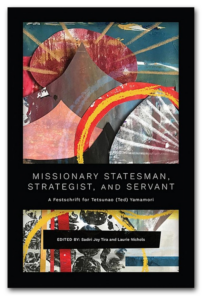 Missionary Statesman, Strategist, and Servant
Missionary Statesman, Strategist, and Servant
A Festschrift for Tetsunao (Ted) Yamamori, ed. Sadiri Joy Tira and Laurie Nichols. Langham Global Library, 2023
© 2023 Sadiri Joy Tira and Laurie Nichols
This chapter is an excerpt from Missionary Statesman, Strategist, and Servant which can be purchased at https://bit.ly/3Bfhwbs
Published 2023 by Langham Global Library
An imprint of Langham Publishing
www.langhampublishing.org
Langham Publishing and its imprints are a ministry of Langham Partnership
Langham Partnership
PO Box 296, Carlisle, Cumbria, CA3 9WZ, UK www.langham.org
ISBNs: 978-1-83973-776-3 Print 978-1-83973-820-3 ePub 978-1-83973-822-7 PDF
[1] . Joseph W. Handley, “Polycentric Mission Leadership” (PhD diss., Fuller Theological Seminary, School of Intercultural Studies, 2020), ProQuest: 27745033. Much of this article was adapted from the dissertation chapters.
[2] . S. Douglas Birdsall, “Conflict and Collaboration: A Narrative History and Analysis of the Interface between the Lausanne Committee for World Evangelization and the World Evangelical Fellowship, the International Fellowship of Evangelical Mission Theologians, and the AD 2000 Movement” (PhD diss., Oxford Centre for Mission Studies, 2012).
[3] . Phill Butler, Well Connected: Releasing Power, Restoring Hope through Kingdom Partnerships ([UK]: Authentic & World Vision, 2006), 41.
[4] . Butler, Well Connected, 51.
[5] . Butler, 101.
[6] . Mark Oxbrow, “Better Together: Partnership and Collaboration in Mission,” Paper,
Forms of Missionary Engagement, Edinburgh 2010 study, in Witnessing to Christ Today, Volume II, eds. Daryl Balia and Kirsteen Kim (Oxford: Regnum, 2010), 116–47.
[7] . Kärin Primuth, “Mission Networks: Connecting the Global Church,” Evangelical Missions Quarterly 51, no. 2: 215.
[8] . Angel Cabrera and Gregory Unruh, Being Global: How to Think, Act, and Lead in a Transformed World (Boston: Harvard Business Review Press, 2012), 12.
[9] . Brad Smith, Cape Town 2010 Table Talk designer. December 2014 interview via Skype.
[10] . Brad Smith.
[11] . Samuel Chiang, catalyst for Orality; CEO of the Seed Company. June 2014 interview in Manhattan Beach, California.
[12] . Tuvya Zaretsky, catalyst for Jewish Evangelism. December 2014 interview via Skype.
[13] . To understand this leadership theory, see Boaz Shamir, Robert House, and Michael Arthur, “The Motivational Effects of Charismatic Leadership: A Self-Concept Based Theory,” Organizational Science 4, no. 4 (1993): 577–94.
[14] . Robert J. House, Peter W. Dorfman, Mansour Javidian, Paul J. Hanges, and Mary F. Sully de Luque, Strategic Leadership across Cultures: The GLOBE Study of CEO Leadership Behavior and Effectiveness in 24 Countries (Thousand Oaks: Sage, 2014), 268.
[15] . Nana Yaw Offei Awuku, global associate director for Generations. October 2018 interview via Skype.
[16] . Ramez Atallah, former vice chair of the board. May 2018 emailed questionnaire.
[17] . Byron Spradlin, catalyst for the Arts. December 2014 interview via Skype.
[18] . Mac Pier, catalyst for Cities. July 2019 interview via phone.
[19] . Phill Butler, catalyst for Partnership. December 2014 interview via Skype.
[20] . October 2018 interview via Skype.
[21] . Anne-Christine Bataillard, former catalyst for Children and Evangelism. May 2019 interview via Skype.
[22] . December 2014 interview via Skype.
[23] . Michael Oh, CEO of the Lausanne Movement. December 2015 interview in King of Prussia, Pennsylvania.
[24] . Lindsay Olesberg, catalyst for Scripture Engagement and Scripture Engagement Director for InterVarsity. July 2018 interview via Skype.
[25] . Bodil Skjøtt, catalyst for Jewish Evangelism. June 2018 interview via Skype.
[26] . June 2014 interview in Manhattan Beach, California.
[27] . Leighton Ford, former executive chair. December 2018 interview via Skype.
[28] . July 2018 interview via Skype.
[29] . October 2018 interview via Skype.
[30] . Doug Birdsall, former executive chair and honorary co-chair. February 2015 interview in El Segundo, California.
[31] . Esme Bowers, board of directors. October 2018 interview via Skype.
[32] . Las Newman, global associate director for Regions. December 2019 emailed response with follow-up call via Skype.
[33] . Joseph Vijayam, senior associate for Technology; CEO of Olive Technology. August 2018 interview via Zoom.
[34] . Sadiri Joy Tira, Global Diaspora Network. December 2014 interview via Skype.
[35] . Patrick Fung, board member. August 2018 interview in Singapore at the OMF Center.
[36] . Ram Gidoomal, former chair of the board. February 2015 interview via Skype.
[37] . July 2019 interview via phone.
[38] . December 2014 interview via Skype.
[39] . December 2014 interview via Skype.
[40] . Chris Wright, former catalyst for Theology Working Group. January 2016 interview via Skype.
[41] . May 2018 emailed questionnaire.
[42] . Matthew Krabill, “Menno Was a Migrant with No Headquarters: The Polycentric Ecclesial Existence of African Immigrant Mennonite Congregations in LA” (PhD diss., Fuller Theological Seminary, 2019), 224.
[43] . Richard Flory and Brad Christerson, The Rise of Network Christianity: How Independent Leaders Are Changing the Religious Landscape (New York: Oxford University Press, 2017), 207.
[44] . Tetsunao Yamamori, The Church Growth Handbook, ed. Win Arn (Pasadena: Church Growth Press, 1979), 184.
[45] . Paul Ariga, November 2021 emailed correspondence.
[46] . Steve Hoke, November 2021 interview via Zoom.
[47] . January 2022 emailed correspondence.
[48] . January 2022 interview via mobile call.
[49] . January 2022 emailed correspondence.
[50] . T. V. Thomas, Global Mobilization Consultation, Brazil, December 2019.




